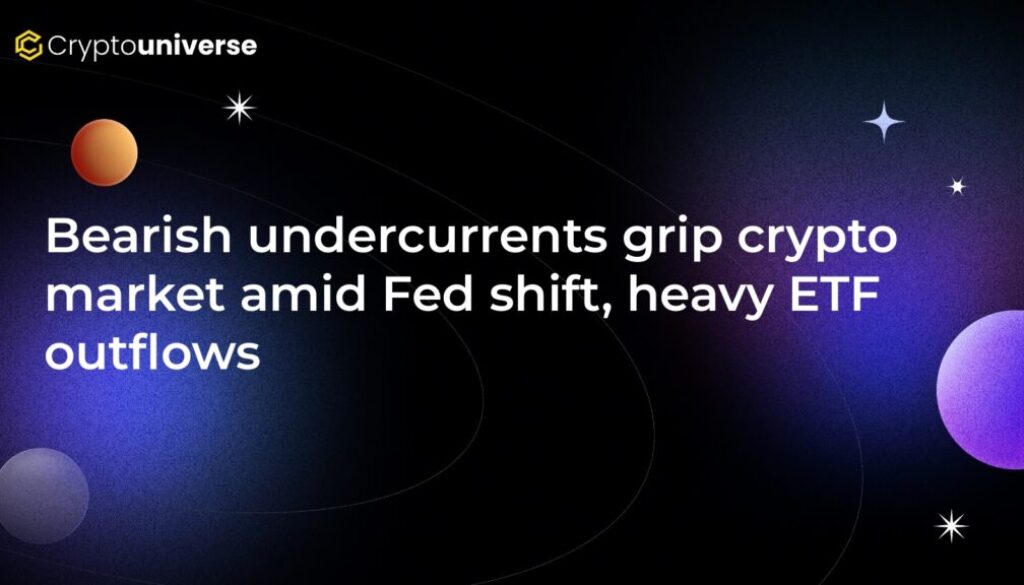Bearish undercurrents grip crypto market amid Fed shift, heavy ETF outflows

The cryptocurrency market is navigating turbulent waters, with a palpable sense of unease replacing the bullish optimism seen earlier this year. Prices across the board are flashing red, and investors are asking a critical question: is this a temporary dip or the start of a more sustained downturn? The answer appears to lie in a powerful combination of macroeconomic pressures and internal market dynamics, specifically a significant policy shift from the U.S. Federal Reserve and a worrying trend of outflows from spot crypto ETFs.
The Federal Reserve’s Hawkish Stance Chills Risk Assets
For months, market participants have been hanging on every word from the Federal Reserve. The central bank’s battle against inflation has been the primary driver of global market trends, and its recent signals have sent a clear message: interest rates are likely to stay higher for longer. This “hawkish” pivot is a major headwind for risk-on assets like cryptocurrencies.
When interest rates are high, safer investments like government bonds and high-yield savings accounts become more attractive. Investors can earn a respectable, low-risk return, which reduces the appeal of speculating on volatile assets like Bitcoin and Ethereum. This concept, known as opportunity cost, is crucial. Why take a significant risk in the crypto market when you can get a guaranteed return elsewhere? This environment drains liquidity from speculative markets, leading to lower buying pressure and downward price action.
A Worrying Reversal: Signal Waning Appetite
The launch of spot Bitcoin ETFs in the United States was hailed as a landmark moment, opening the floodgates for institutional capital. The initial inflows were staggering, driving the market to new heights. However, the tide has turned dramatically. In recent weeks, these same ETFs have experienced sustained and significant outflows.
- Direct Selling Pressure: When investors sell their ETF shares, the fund manager must sell the corresponding amount of the underlying asset (e.g., Bitcoin) on the open market. This creates direct and immediate selling pressure, driving the price down.
- A Barometer of Sentiment: ETF flows are seen as a proxy for institutional and mainstream investor sentiment. Consistent outflows suggest that larger players are de-risking their portfolios, taking profits, or losing confidence in the market’s short-term prospects.
- Psychological Impact: The constant reporting of negative flows creates a bearish narrative that can spook retail investors, potentially leading to panic selling and exacerbating the downturn.
This reversal from massive inflows to heavy outflows is a critical factor behind the current market weakness. The very vehicle that propelled the bull run is now acting as an anchor, weighing down prices as institutional appetite cools.
On-Chain Metrics and Technical Analysis Paint a Sobering Picture
Beyond the Fed and ETFs, other indicators confirm the bearish sentiment:
- Falling Trading Volume: Lower trading volumes indicate a lack of conviction from buyers. Without a surge in volume, any price bounce is likely to be short-lived and unsustainable.
- Fear & Greed Index: The popular sentiment gauge has plunged into “Fear” or even “Extreme Fear” territory, reflecting widespread anxiety among market participants.
- Breaking Key Support Levels: Major cryptocurrencies like Bitcoin and Ethereum have broken below crucial technical support levels, such as the 50-day and 100-day moving averages. This often signals to technical traders that further downside is likely.
What to Watch For: Navigating the Bear Market
In the current climate, investors are closely watching for any signs of a potential reversal. The key catalysts to monitor include:
Macroeconomic Shifts: Any indication from the Federal Reserve that they might pivot to a more “dovish” (rate-cutting) stance sooner than expected could reignite interest in risk assets. Keep an eye on inflation data (CPI reports) and Fed meeting minutes.
ETF Flow Reversal: A return to sustained positive inflows for spot crypto ETFs would be a powerful bullish signal, indicating that institutional confidence is returning.
Regulatory Clarity: Positive regulatory developments in key jurisdictions like the United States could provide a much-needed long-term boost to the market’s confidence.
Conclusion: A Perfect Storm of Bearish Factors
The crypto market is currently caught in a perfect storm. The macroeconomic environment, dictated by a hawkish Federal Reserve, is fundamentally unfavorable for speculative assets. This is compounded by internal weakness, most visibly demonstrated by the heavy outflows from the very ETFs that were supposed to usher in a new era of institutional adoption. While volatility is inherent to the crypto space, the confluence of these powerful bearish forces suggests that caution is warranted. Investors will be watching closely to see if the market can weather this storm or if a longer, colder crypto winter is setting in.


